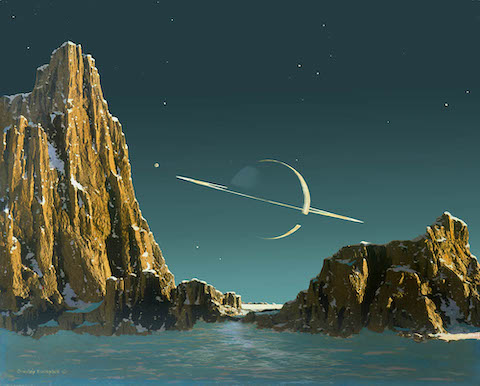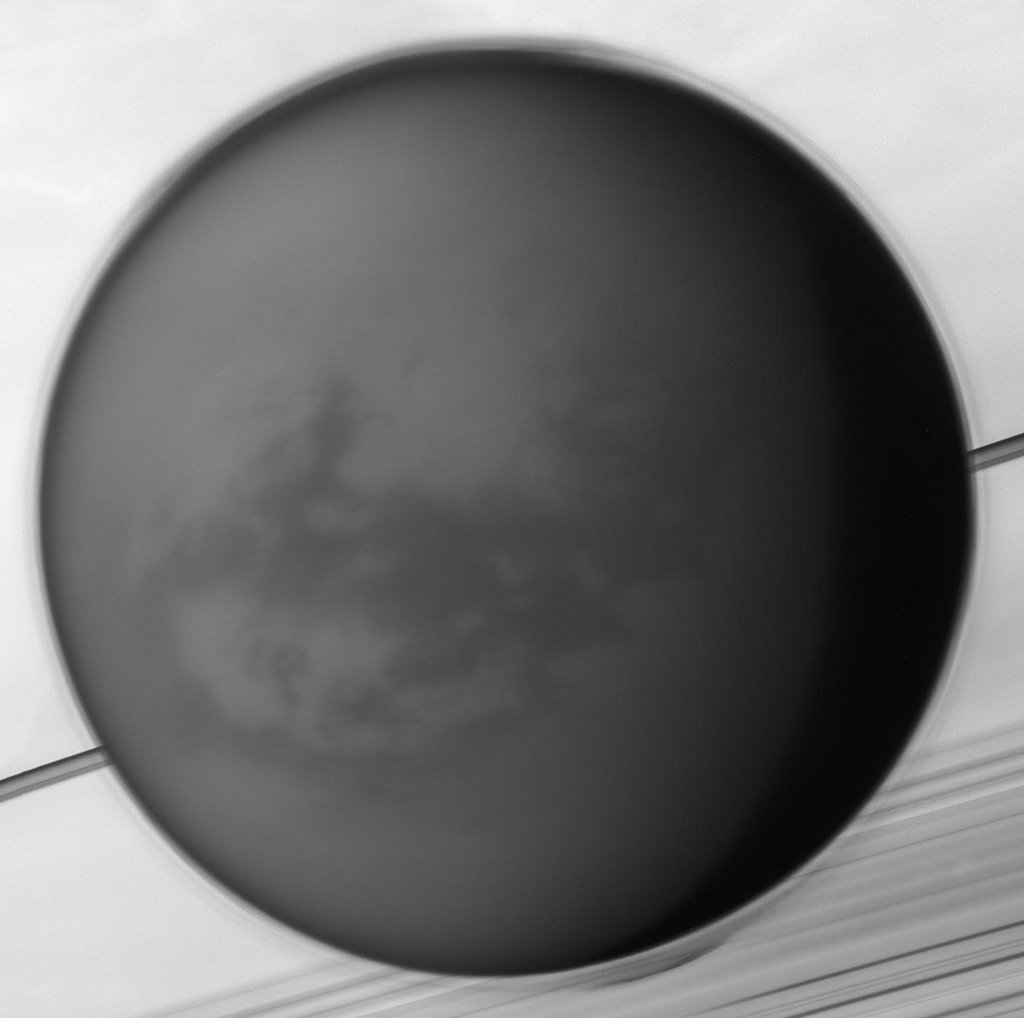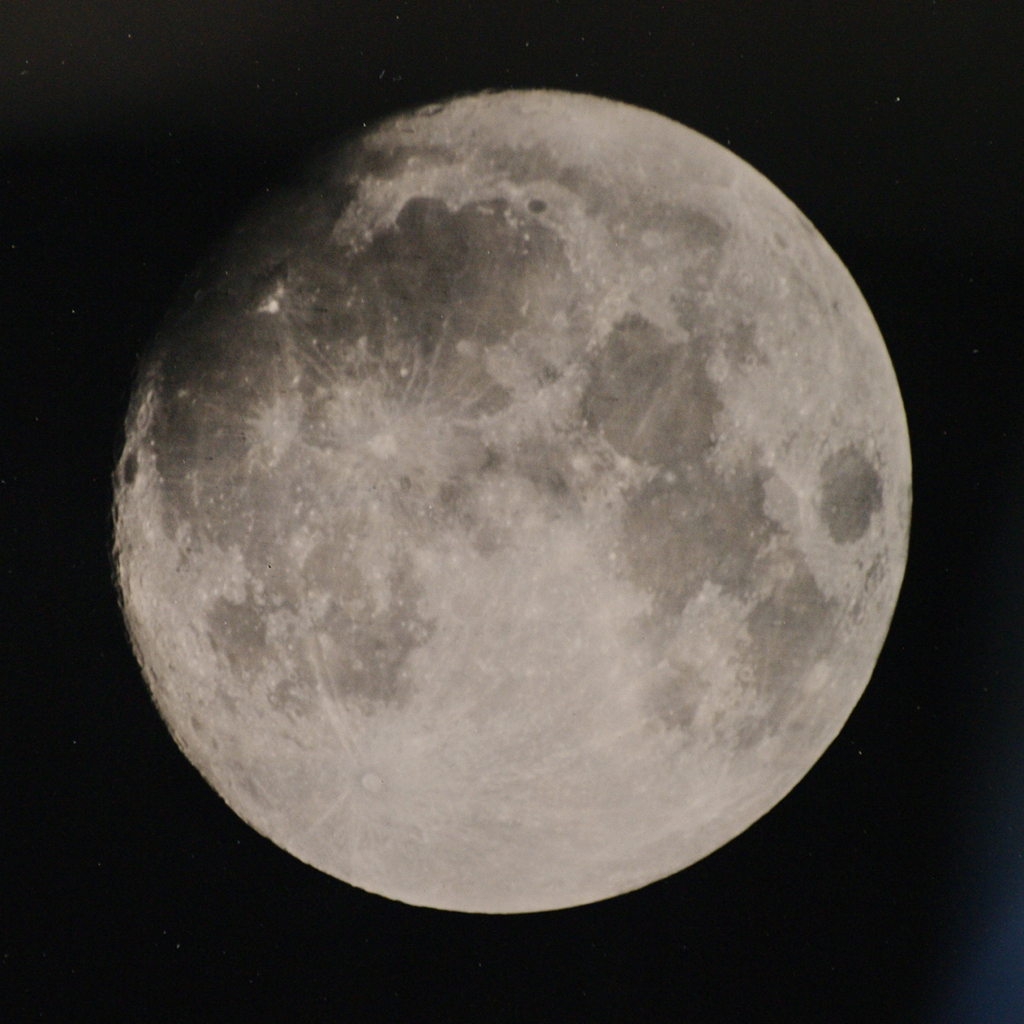Nombre total de pages vues
10/01/2021
AERONAUTIQUE - L’avion transparent alimenté par votre chaleur corporelle
09/01/2021
ASTRONOMY - Titan: Moon over Saturn
2021 January 9
Image Credit: NASA, JPL-Caltech, Space Science Institute
Explanation: Like Earth's moon, Saturn's largest moon Titan is locked in synchronous rotation. This mosaic of images recorded by the Cassini spacecraft in May of 2012 shows its anti-Saturn side, the side always facing away from the ringed gas giant. The only moon in the solar system with a dense atmosphere, Titan is the only solar system world besides Earth known to have standing bodies of liquid on its surface and an earthlike cycle of liquid rain and evaporation. Its high altitude layer of atmospheric haze is evident in the Cassini view of the 5,000 kilometer diameter moon over Saturn's rings and cloud tops. Near center is the dark dune-filled region known as Shangri-La. The Cassini-delivered Huygens probe rests below and left of center, after the most distant landing for a spacecraft from Earth.
07/01/2021
ASTRONOMY - Total Solar Eclipse 2020
2021 January 7
Image Credit & Copyright: Miloslav Druckmuller, Andreas Moller, (Brno University of Technology),
Explanation: Along a narrow path crossing southern South America through Chile and Argentina, the final New Moon of 2020 moved in front of the Sun on December 14 in the year's only total solar eclipse. Within about 2 days of perigee, the closest point in its elliptical orbit, the New Moon's surface is faintly lit by earthshine in this dramatic composite view. The image is a processed composite of 55 calibrated exposures ranging from 1/640 to 3 seconds. Covering a large range in brightness during totality, it reveals the dim lunar surface and faint background stars, along with planet-sized prominences at the Sun's edge, an enormous coronal mass ejection, and sweeping coronal structures normally hidden in the Sun's glare. Look closely for an ill-fated sungrazing Kreutz family comet (C/2020 X3 SOHO) approaching from the lower left, at about the 7 o'clock position. In 2021 eclipse chasers will see an annular solar eclipse coming up on June 10. They'll have to wait until December 4 for the only total solar eclipse in 2021 though. That eclipse will be total along a narrow path crossing the southernmost continent of Antarctica.
05/01/2021
ASTRONOMY - The Small Cloud of Magellan
2021 January 5
Image Credit & Copyright: José Mtanous
Explanation: What is the Small Magellanic Cloud? It has turned out to be a galaxy. People who have wondered about this little fuzzy patch in the southern sky included Portuguese navigator Ferdinand Magellan and his crew, who had plenty of time to study the unfamiliar night sky of the south during the first circumnavigation of planet Earth in the early 1500s. As a result, two celestial wonders easily visible for southern hemisphere skygazers are now known in Western culture as the Clouds of Magellan. Within the past 100 years, research has shown that these cosmic clouds are dwarf irregular galaxies, satellites of our larger spiral Milky Way Galaxy. The Small Magellanic Cloud actually spans 15,000 light-years or so and contains several hundred million stars. About 210,000 light-years away in the constellation of the Tucan (Tucana), it is more distant than other known Milky Way satellite galaxies, including the Sagittarius Dwarf galaxy and the Large Magellanic Cloud. This sharp image also includes the foreground globular star cluster 47 Tucanae on the right.
04/01/2021
AERONAUTIQUE - Vacances au Pole
Se prélasser à côté des ours polaires pour les vacances, un rêve à la portée de tous en l'an 2000 ! Enfin, c'est ce que l'on croyait dans les années 1900. Des ballons gonflants auraient emmené de larges paquebots flottants vers la destination glacée. On imagine que le chauffage était intégré aux plans du navire !
© Hildebrands
03/01/2021
ASTRONOMY - A Phoenix Aurora over Iceland
2021 January 3
Image Credit & Copyright: Hallgrimur P. Helgason; Rollover Annotation: Judy Schmidt
Explanation: All of the other aurora watchers had gone home. By 3:30 am in Iceland, on a quiet September night, much of that night's auroras had died down. Suddenly, unexpectedly, a new burst of particles streamed down from space, lighting up the Earth's atmosphere once again. This time, surprisingly, pareidoliacally, the night lit up with an amazing shape reminiscent of a giant phoenix. With camera equipment at the ready, two quick sky images were taken, followed immediately by a third of the land. The mountain in the background is Helgafell, while the small foreground river is called Kaldá, both located about 30 kilometers north of Iceland's capital Reykjavík. Seasoned skywatchers will note that just above the mountain, toward the left, is the constellation of Orion, while the Pleiades star cluster is also visible just above the frame center. The 2016 aurora, which lasted only a minute and was soon gone forever -- would possibly be dismissed as an fanciful fable -- were it not captured in the featured, digitally-composed, image mosaic.
02/01/2021
SPACE ART - Saturne vue de Titan
Si Lucien Rudaux est considéré comme le “grand-père” du Space art, Chelsey Bonestell est bien le père de la discipline. L’Américain a démarré sa carrière comme architecte, en participant notamment à l’élaboration de la façade du Chrysler Building à New York ou du bâtiment de la Cour suprême des États-Unis. Il se spécialise ensuite dans les effets spéciaux à Hollywood, par exemple pour les films Le bossu de Notre-Dame (1939) ou Citizen Kane (1941).
Toutefois, passionné depuis toujours par l’astronomie, Chesley Bonestell décide d’utiliser ses compétences afin de créer des œuvres entrant dans la catégorie du Space art. Ainsi, il s’inspire très largement de Lucien Rudaux, et associe miniatures d’argile, astuces photographiques et techniques de peinture pour élaborer des tableaux au réalisme saisissant. C’est en 1944 dans le magazine Life que paraît sa première grande réalisation : une série de représentations de Saturne vue de ses lunes.

ASTRONOMY - 21st Century Wet Collodion Moon
2021 January 2
Image Credit & Copyright: Mike Smolinsky
Explanation: In the mid 19th century, one of the first photographic technologies used to record the lunar surface was the wet-plate collodion process, notably employed by British astronomer Warren De la Rue. To capture an image, a thick, transparent mixture was used to coat a glass plate, sensitized with silver nitrate, exposed at the telescope, and then developed to create a negative image on the plate. To maintain photographic sensitivity, the entire process, from coating to exposure to developing, had to be completed before the plate dried, in a span of about 10 to 15 minutes. This modern version of a wet-plate collodion image celebrates lunar photography's early days, reproducing the process using modern chemicals to coat a glass plate from a 21st century hardware store. Captured last November 28 with an 8x10 view camera and backyard telescope, it faithfully records large craters, bright rays, and dark, smooth mare of the waxing gibbous Moon. Subsequently digitized, the image on the plate was 8.5 centimeters in diameter and exposed while tracking for 2 minutes. The wet plate's effective photographic sensitivity was about ISO 1. In your smart phone, the camera sensor probably has a photographic sensitivity range of ISO 100 to 6400 (and needs to be kept dry ...).
ASTRONOMY - The Observable Universe
2025 November 23 The Observable Universe Illustration Credit & Licence : Wikipedia , Pablo Carlos Budassi Explanation: How far can ...

-
2022 September 26 All the Water on Planet Earth Illustration Credit: Jack Cook, Adam Nieman, Woods Hole Oceanographic Institution ; Data ...
-
2025 May 11 The Surface of Venus from Venera 14 Image Credit: Soviet Planetary Exploration Program , Venera 14 ; Processing & Copyri...







